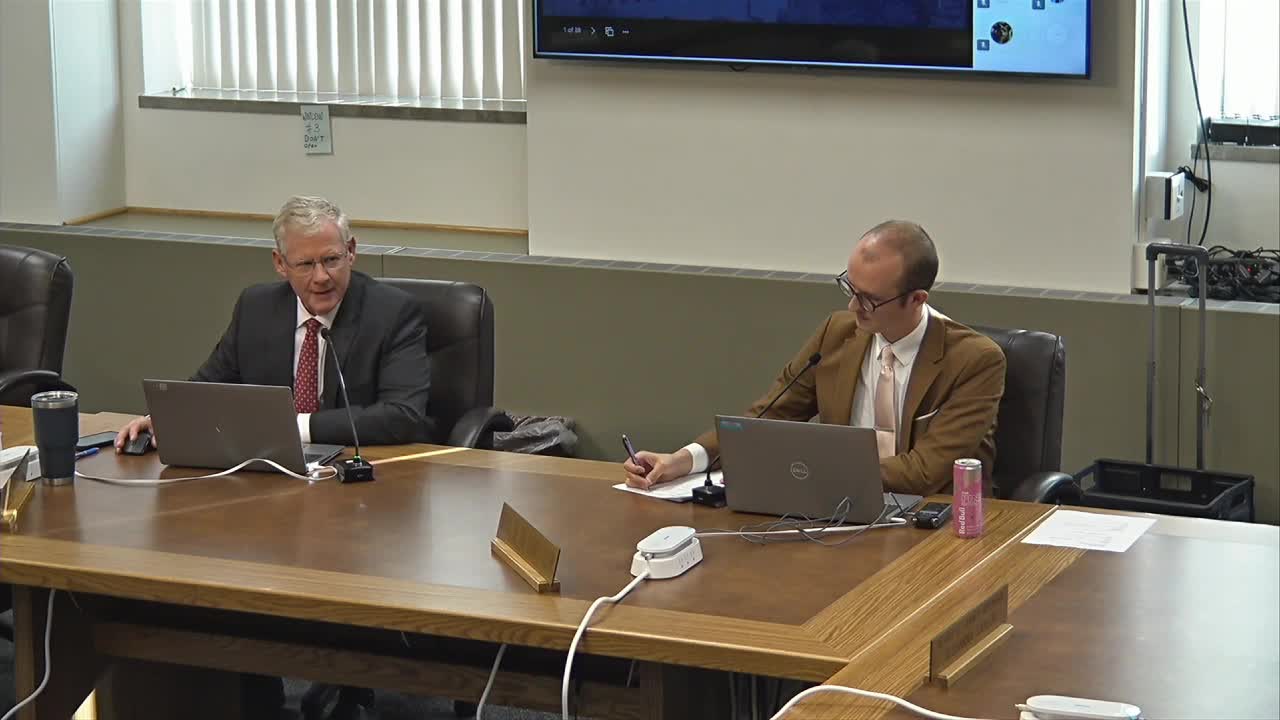Comptroller presents 2026 recommended budget: $1.4 billion expenditures, tax levy up $12.1 million driven by debt service
October 09, 2025 | Milwaukee County, Wisconsin
This article was created by AI summarizing key points discussed. AI makes mistakes, so for full details and context, please refer to the video of the full meeting. Please report any errors so we can fix them. Report an error »

Milwaukee County’s office of the comptroller presented an overview of the County Executive’s recommended 2026 budget to the Committee on Finance, summarizing totals, key drivers and constraints tied to the county’s tax-levy cap.
The overview, delivered by Steven Cady, director of research and policy, said the recommended budget shows roughly $1.4 billion in total expenditures (a decrease of about $15 million versus the prior year presentation) and about $1.1 billion in total revenues (a decline of about $28 million). The presentation attributed much of that apparent drop to an accounting change shifting approximately $34 million in Children's Long-Term Support (CLTS) expenditures and revenues off the county books and onto state books, with no service impact asserted.
Why it matters: The recommended tax levy increases by $12.1 million — about 4.1% — and, as presented, the budget is constructed up to the county’s allowable levy cap. County staff told supervisors the principal driver of the allowable levy increase is a nearly $12 million rise in debt-service costs tied to previously approved capital borrowing and scheduled debt-service increases in 2027 tied to forensic science facility bonds.
Key budget elements cited in the presentation include: the 0.5% legacy county sales tax budgeted at roughly $106.9 million and the state-prescribed 0.4% sales-tax tranche projected at about $85.5 million for 2026, with statutory limits on some uses of the 0.4% tranche (notably to address pension liabilities). Debt-service reserve contributions and the use of surpluses were described as one-time tools used in prior years to manage levy pressures; staff warned that tapping reserves is not a permanent fix and that a continuing structural gap remains in the five-year forecast. The comptroller’s office and budget staff said departments were given targeted levy reduction targets and asked to absorb cost-to-continue growth to close roughly a $46.6 million structural gap in the five-year outlook.
Supervisors and county staff discussed the mechanics of the tax-levy cap, drivers of the allowable levy change (including net new construction and debt-service costs), and how the 0.4% sales tax mix between paying pension obligation bond debt and the county’s ERS normal cost can affect the levy and allowable increase.
Ending: County staff offered written materials and a fuller report (filed as the county’s budget file) and said they would provide additional charts and the PowerPoint to supervisors; committee members flagged the potential need for a debt-service budget amendment after forthcoming 2025 bond-sale results.
The overview, delivered by Steven Cady, director of research and policy, said the recommended budget shows roughly $1.4 billion in total expenditures (a decrease of about $15 million versus the prior year presentation) and about $1.1 billion in total revenues (a decline of about $28 million). The presentation attributed much of that apparent drop to an accounting change shifting approximately $34 million in Children's Long-Term Support (CLTS) expenditures and revenues off the county books and onto state books, with no service impact asserted.
Why it matters: The recommended tax levy increases by $12.1 million — about 4.1% — and, as presented, the budget is constructed up to the county’s allowable levy cap. County staff told supervisors the principal driver of the allowable levy increase is a nearly $12 million rise in debt-service costs tied to previously approved capital borrowing and scheduled debt-service increases in 2027 tied to forensic science facility bonds.
Key budget elements cited in the presentation include: the 0.5% legacy county sales tax budgeted at roughly $106.9 million and the state-prescribed 0.4% sales-tax tranche projected at about $85.5 million for 2026, with statutory limits on some uses of the 0.4% tranche (notably to address pension liabilities). Debt-service reserve contributions and the use of surpluses were described as one-time tools used in prior years to manage levy pressures; staff warned that tapping reserves is not a permanent fix and that a continuing structural gap remains in the five-year forecast. The comptroller’s office and budget staff said departments were given targeted levy reduction targets and asked to absorb cost-to-continue growth to close roughly a $46.6 million structural gap in the five-year outlook.
Supervisors and county staff discussed the mechanics of the tax-levy cap, drivers of the allowable levy change (including net new construction and debt-service costs), and how the 0.4% sales tax mix between paying pension obligation bond debt and the county’s ERS normal cost can affect the levy and allowable increase.
Ending: County staff offered written materials and a fuller report (filed as the county’s budget file) and said they would provide additional charts and the PowerPoint to supervisors; committee members flagged the potential need for a debt-service budget amendment after forthcoming 2025 bond-sale results.
Don't Miss a Word: See the Full Meeting!
Go beyond summaries. Unlock every video, transcript, and key insight with a Founder Membership.
✓
Get instant access to full meeting videos
✓
Search and clip any phrase from complete transcripts
✓
Receive AI-powered summaries & custom alerts
✓
Enjoy lifetime, unrestricted access to government data
30-day money-back guarantee

